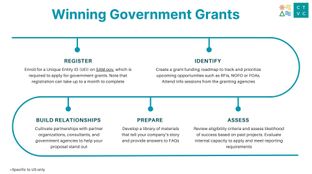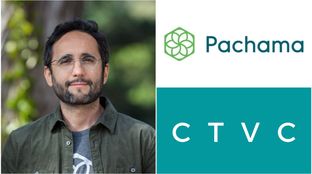
🌎 Get ready with me: Government grants edition 💅💵
A founder’s guide to winning non-dilutive funding with Elemental Excelerator
Watershed raised a much hyped Series A round which brought together Sequoia’s Michael Moritz and Kleiner’s John Doerr as co-leads of the investment for the first time since 1999.

Last week we spoke with Patch about their plug and play solution for carbon removals. This week we hone in on the other side of the corporate net zero equation – decarbonizing operations and supply chains. Watershed raised a much hyped Series A round which brought together Sequoia’s Michael Moritz and Kleiner’s John Doerr as co-leads of the investment for the first time since 1999. Recent announcements from Sweetgreen, Square, and Shopify about how they’ve decarbonized their supply chains using Watershed have shown how the company approaches climate impact through marketplaces. In this conversation we probe Co-Founder Taylor Francis on Watershed’s business model and how they’re building a multi-decadal business by enabling corporate decarbonization.
What’s the story behind Watershed? How did your team’s experience at Stripe influence the development of the platform?
Watershed emerged from a combination of a longtime passion for solving climate change and our experience building technology products and businesses. I first became both scared of and energized by the climate crisis after watching An Inconvenient Truth. I was part of the Climate Reality Project and spent high school presenting a local version of that slideshow to schools and community groups. Likewise, my co-founders are also long-standing climate change advocates – Christian’s first internet project raised money for environmental work, and Avi is an avid skier and environmentalist.
The three of us met at Stripe where we ran product, operations, and engineering teams. Christian led the creation of Stripe’s negative emissions commitment and carbon removal fund. That work taught us that companies can have a tremendous impact on climate, and it’s good business to do so—investors, customers, and employees all expect businesses to decarbonize. But it’s still extremely hard for companies to change operations to keep carbon out of the atmosphere. So we decided to start Watershed to build tools that enable companies to get to net zero – or negative – carbon.
Why do you think that Stripe has been one of the leading companies in pioneering corporate carbon removal?
Instead of optimizing for a corporate sustainability report that goes out once a year, Stripe is laser focused on having the biggest possible impact on solving climate change by leveraging its resources, products, and people to bring down CO2 emissions. They decided to focus on carbon removal, which is just crying out for a force to bring the technology down the learning and cost curves.
Stripe’s forward-thinking approach on carbon removal is a good example of how companies ought to be thinking about climate action – not in terms of what sounds good, but rather making decisions that can significantly change the CO2 graph. For companies that are taking climate change seriously, Watershed has developed a set of tools that enable them to accurately measure where they are today, come up with a plan for emissions reduction, embed carbon decision making into regular business operations, and report on their progress. That impulse to have the biggest possible impact on climate guides all of our customers – whether it’s Sweetgreen’s commitment to cut emissions in half, Square’s net zero target, or Shopify’s approach to remote work.
What have been the key problems that companies face when trying to decarbonize? How have these challenges framed Watershed’s platform?
Watershed has three goals: Let companies measure their impact, take action to reduce emissions, and make reports on progress. Every ton of carbon that goes into the atmosphere can be traced back to a business making a decision, whether that’s energy supply, cloud computing, supply chain sourcing, logistics or transportation. Companies trying to have an impact on climate face two major issues: data and market.
The data problem is that companies don’t know the carbon impact of their decisions. The status quo in carbon accounting depends on industry average assumptions, which lends zero insight into how a company can make decisions in a different way to reduce emissions. So the first problem that we’re trying to solve at Watershed is providing more actionable data so companies can know the carbon impact of their decisions.
The second issue is a market problem. If you’re a huge corporation like Apple and the majority of your emissions footprint comes from aluminum, you can form a multi-million dollar joint venture to invent zero carbon aluminum. However, most companies don’t have that market sway on their own. We’re building a marketplace that matches companies on the journey to decarbonize with technologies for a zero carbon future.
Over the last decade, decarbonization has been led by large tech companies who have brilliant engineers, analytical resources, and market power. We’re trying to build the platform so any company can have that same actionable carbon decisionmaking and market power by aggregating multiple companies to put their joint power behind clean solutions.
Do you think that the “data issue” is a need for new data or more actionable data?
All of the above. In the ‘old world’, companies fill out a bunch of rows in a spreadsheet, spend 3 months chasing people for inputs, and then end up with a PDF of their rough carbon footprint – which is already stale at delivery. This process 1) takes too long, 2) isn’t specific enough because it’s based on industry averages, and 3) is completely blind to suppliers. So much of decarbonization will cascade down through supply chains, so it will be critical to know the carbon impact of current and alternative suppliers.
To solve this supply chain problem we’ve designed Watershed to be really fast at pulling data straight from the source of truth – like an X-ray of the entire business for every single line item and purchase order. Sweetgreen is a great case study: they use Watershed to design new menu items with an eye towards carbon. They’re making decisions about what chicken, cheese, kale, and avocado go into a salad based on whether these suppliers have implemented low carbon practices on the farms.
What’s the ideal profile of a Watershed customer?
We work with companies across different carbon-intensive supply chains including payments, healthcare, manufacturing, electronics, and food logistics. I’ve learned from working with our customers that one needn’t work directly with a cement manufacturer to decarbonize cement, or directly with a trucker to decarbonize logistics. Think about all of the technology companies building huge offices, all of the produce moving through the supply chains of Imperfect Foods or Sweetgreen, or all of the commerce delivered by Shopify. There’s this much more extensive carbon network, which companies can have a big impact on though their decision-making.
We’re excited about companies trying to do climate in a new way. The old, slow model of decarbonization that’s focused on measurement and offsets isn’t the right recipe for getting us to zero by 2050. We’re enabling a new model for companies to start measuring and reducing as soon as possible. Our customers share a new DNA of corporate climate action; they deeply understand their carbon network and don’t bucket their emissions into Scope 1, 2, or 3 because it’s all emissions that they’re responsible for. When it comes to getting to zero, these companies also prefer permanent carbon removal.
Walk us through the Watershed value chain. How do your customers get integrated and on-boarded to the platform?
The Watershed platform drives decarbonization through three steps: measure, reduce, and report. We help companies measure their footprint in days (not months) and can trace emissions to their origins to see how they stack up to other industry players. On the reduction side, we recommend steps for companies to cut carbon and help them actually execute on that plan. Companies use Watershed to engage suppliers on their carbon impact and help them set targets if they haven’t yet done so. Companies can also offset and remove carbon through our marketplace, where they can buy clean power and fund impactful carbon removal projects. The final step is handling all reporting so companies have the means to engage their employees and customers, alongside best in class climate disclosures.
How do you work with corporate internal teams? Are you a replacement to the sustainability team?
Cutting carbon is hard and it’s deeply interwoven into all business operations. If we want to have any chance at reaching economy-wide net zero, we need sustainability leaders to be focused on the real decisions that drive decarbonization, not preparing corporate sustainability reports. Our customers use Watershed to know where they stand, come up with a plan, and track their work so they can spend all of their time on rearchitecting their business in a low carbon way.
So, why is Watershed best equipped to help companies do that hard internal decarbonization work?
Every function or organization within a company has come to rely on purpose-built software to accomplish their goals – sales & support, product & engineering, supply chain & logistics, the list goes on. Climate is the most important function at every company over the next decade, and the teams working on climate need best-in-class tools.
Fundamentally, it comes back to the data and market problem. On the data side, companies need to know where they stand, set goals, and have a common language to prioritize initiatives and make sure results are being delivered. Watershed is providing climate teams with the same type of high performance, data-driven, real-time tools that organizations expect for every other function of their business.
On the market side, we’re doing the hard work of identifying the most promising low carbon technologies so that through Watershed it’s point and click for companies to put together a portfolio of carbon removal supplier partners or clean power developers who are adding new green power to the grid. We’ve helped companies buy clean cement for their offices, or – in the case of Sweetgreen – use Watershed to buy sustainable ingredients. Oftentimes, people think about the marketplace for decarbonization as offsets or credits, but the Watershed marketplace is much broader – companies are using our tools to decarbonize everything from salads, to semiconductors, to Bitcoin.
How important is the role of talent as a driver of decarbonization adoption or ROI?
It’s super important. The trifecta of stakeholders making this a tipping point moment for climate action are employees, investors, and customers. People want to work for companies doing “the right thing” on climate, and talent is the single most important resource for companies today. It’s also amazing to see how quickly investors are moving ESG from optional to required. B2B businesses are starting to work carbon into their RFPs, and in B2C it’s well known that sustainable consumer products outperform.
How does Watershed think about corporate sustainability reporting requirements like TCFD? How will legislation impact your business?
There’s a lot of excitement and momentum for pricing climate risk in the current administration. The UK has set the standard here so far – they require companies to report on their carbon footprint and will mandate TCFD disclosures by 2025. We expect that approach to be the blueprint for major centers of capital soon. Even in the absence of regulation, the train has left the station on how central climate is to how companies do business. But make no mistake – policy is the most important lever for climate action by far.
Watershed raised a hot Series A round from some powerhouse investors including Sequoia’s Michael Moritz and Kleiner Perkins’ John Doerr, who also joined your board. What have you learned about generalist investors’ current appetite for climate tech investing?
Throughout the raise we optimized for bringing on board partners who have experience building multi-decade enduring companies because we view Watershed as a multi-decade project. Between John and Mike, they’ve been a part of an astonishing array of transformational companies. We’re really grateful to have them on board with Watershed. It’s exciting that the time is finally here for all of those climate technologies to not just be good projects but also good businesses.
Want to build the next watershed moment in climate, whether that’s building software, coaching customers, or scaling an organization? Watershed is hiring across the business – and is particularly eager to talk to engineers and sales leaders.
Interested in more content like this? Subscribe to our weekly newsletter on Climate Tech below!

A founder’s guide to winning non-dilutive funding with Elemental Excelerator

Infrastructure investing for impact with Banyan Infrastructure's Amanda Li

Venturing into nature with Diego Saez-Gil at Pachama